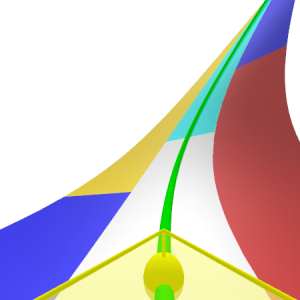Introduction
[color=#999999]This activity belongs to the GeoGebra [i][url=https://www.geogebra.org/m/r2cexbgp]Road Runner (beep, beep)[/url][/i] book. [/color][br][br][right][i]If the mountain won't come to Muhammad, then Muhammad must go to the mountain.[/i][/right]The main objective of this GeoGebra book is to show various ways of representing curves and surfaces, including a local perspective, as if we were navigating (surfing) along the path. [br][br]Using GeoGebra's 3D view to display what a local observer, a camera, would see while traveling through space entails, at the time of writing this, a fundamental difficulty. The 3D view always displays a parallelepiped with edges parallel to the Cartesian axes. It is not possible to define an arbitrary orthoedric space; instead, an interval between minimum and maximum values must be established for each coordinate. This means that out of the infinite number of rectangles sharing two given opposite vertices, GeoGebra only accepts the one with edges parallel to the axes as the base of the 3D scene.[br][br]For example, it is not possible to set the green parallelepiped, with opposite corners A(0, 0, 0) and B(3, 4, 1), and another vertex at C(4, 2, 0), as the scene. Attempting to do so, as shown in the following construction, results in creating the red orthoedron, with corners A and B, but with edges parallel to the axes.[br][br]To overcome this difficulty, we will follow the aforementioned proverb: keep the camera fixed and dynamically move the figure (curve or surface) in front of the camera. Mathematically (and, I would add, physically, as Galileo would [url=https://en.wikipedia.org/wiki/Galilean_invariance][img]https://www.geogebra.org/resource/scjbyz2p/0tuzuVw455vxurEw/material-scjbyz2p.png[/img][/url]), this is equivalent to changing the reference system. Additionally, we will make use of four concepts: projection, homotopy, the Frenet frame, and the normal vector to a surface at a given point.
[color=#999999][color=#999999]Author of the construction of GeoGebra: [color=#999999][url=https://www.geogebra.org/u/rafael]Rafael Losada[/url][/color][/color][/color]
Maze
[color=#999999]This activity belongs to the GeoGebra [i][url=https://www.geogebra.org/m/r2cexbgp]Road Runner (beep, beep)[/url][/i] book. [/color][br][br]In this construction, we test the technique of automatically navigating through a maze by always choosing the right-hand wall. The automaton (red point) [b]has no information about the shape of the maze[/b]. There is no predefined path. It only detects if there is free space to its right (in which case it turns right to stick to the right wall) or if there is an obstacle in front (in which case it turns left). This simple rule is enough to keep it from straying from its right-hand wall and to successfully navigate out of the maze.[br][br]In the construction, click the play button (in the lower left corner of the top panel).[br][br][color=#cc0000]Note: To improve execution agility, it is recommended to [b]download [/b]the GGB file. Remember that, in this case, it may be necessary to [b]readjust [/b]the height of the 3D view to reposition the point in the desired position. The magenta slider that appears once downloaded may be helpful for this adjustment.[/color]
[color=#999999][color=#999999]Author of the construction of GeoGebra: [color=#999999][url=https://www.geogebra.org/u/rafael]Rafael Losada[/url][/color][/color][br][/color]
Curves
[color=#999999]This activity belongs to the GeoGebra [i][url=https://www.geogebra.org/m/r2cexbgp]Road Runner (beep, beep)[/url][/i] book. [/color][br][br]In this construction, you can see an example with curves. The [img]https://www.geogebra.org/resource/njceatrr/VDybceHABmIBMmu5/material-njceatrr.png[/img] button allows you to choose from some predefined ones:[br][list][*]Circle[/*][*]Trefoil knot[/*][*]Granny knot[br][/*][/list]You can also choose any other curve you want, as long as you know a parameterization, by checking the Specify checkbox.[br][br][color=#cc0000]Note: To improve execution agility, it is recommended to download the GGB file. Remember that, in this case, it may be necessary to readjust the height of the 3D view to reposition the point in the desired position. For this adjustment, the magenta slider that appears once downloaded may be helpful (you may need to temporarily hide the 2D graphics view to see it).[/color]
[color=#999999][color=#999999]Author of the construction of GeoGebra: [color=#999999][url=https://www.geogebra.org/u/rafael]Rafael Losada[/url][/color][/color][/color]
Cylinder
[color=#999999]This activity belongs to the GeoGebra [i][url=https://www.geogebra.org/m/r2cexbgp]Road Runner (beep, beep)[/url][/i] book. [/color][br][br]In this construction, you can see an example with surfaces. The [img]https://www.geogebra.org/resource/njceatrr/VDybceHABmIBMmu5/material-njceatrr.png[/img] button allows you to choose from some predefined paths:[br][list][*]Circle (t, 0) [/*][*]Segment (0, t)[/*][*]Helix (t, t)[/*][*]Solenoid (5t, t)[/*][*]Ellipse (t, sen(t))[br][/*][/list]You can also choose any other paths you want, as long as you know a parameterization, by checking the Specify checkbox.[br][br][color=#cc0000]Note: To improve execution agility, it is recommended to download the GGB file. Remember that, in this case, it may be necessary to readjust the height of the 3D view to reposition the point in the desired position. For this adjustment, the magenta slider that appears once downloaded may be helpful (you may need to temporarily hide the 2D graphics view to see it).[/color]
[color=#999999][color=#999999]Author of the construction of GeoGebra: [color=#999999][url=https://www.geogebra.org/u/rafael]Rafael Losada[/url][/color][/color][br][/color]
